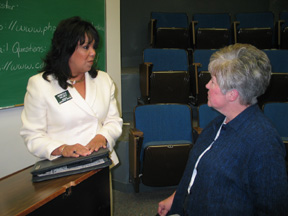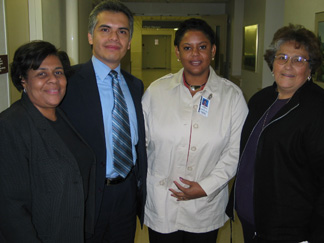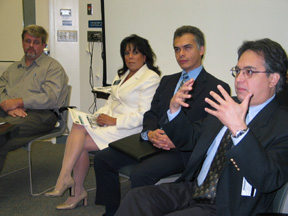 |
Susan Langdon, right, clinical coordinator, UNMC medical technology education, chats with Rebecca Valdez, executive director of the Chicano Awareness Center in Omaha, after the forum. |
National Hispanic Heritage Month was Sept. 15-Oct.15. In observance, the UNMC Employee Diversity Network (EDN) sponsored a panel discussion on “Problems Facing Hispanic Immigrants – Healthcare and Education.” The panelists included Jose Romero, M.D., associate professor in the department of pediatrics-infectious diseases; Luis Alva, Deputy Consul of Mexico; Ed Leahy, director of the Iowa-Nebraska Immigrants Rights Network; and Rebecca Valdez, executive director of the Chicano Awareness Center in Omaha.
The far-reaching effects of Latino immigration on America’s economy and political fabric discussed that day can be seen in three recent developments.
In October, 900 riders – mostly Latino – rode 18 buses in a transcontinental Immigrant Workers Freedom Ride that culminated in New Jersey with a rally that drew more than 25,000 people. Inspired by the historic 1961 freedom rides that sought to integrate segregated bus terminals in the South, the organizers’ primary goal was to draw attention the many disparities affecting Latinos in America.
In California, one of Governor-elect Arnold Schwarzenegger’s most immediate challenges will be to fulfill his campaign promise to repeal the law allowing illegal immigrants to acquire California driver’s licenses – without poisoning his party’s relationship with Latinos – one-third of the state’s population.
 |
From left, Aubrey Orduna, director, Diversity Services and Practical Nursing, Clarkson College; Luis Alva, Deputy Consul of Mexico; Linda Cunningham, coordinator, cultural competence, UNMC Community and Multicultural Affairs and co-chair of EDN; and Linda Nieto, coordinator of on-line education, Clarkson College. |
“Latinos are having tremendous impact in our country, especially when welcomed as a vibrant new member of a community,” Alva said. “Schuyler, Neb., for example, for the first time in its history has achieved 5,000 residents and earned the classification as a city. Westport, Neb., is now 32 percent Latino.
“We’re bringing families, badly needed labor, economic development and a boost in school enrollments in areas where schools may have had to close for lack of students. Latinos even revitalize use of many municipal parks because our culture places great emphasis on family social gatherings in public parks.”
Dr. Romero noted that concern for the immigrants’ burden on local community health systems is misplaced and really more a matter of cultural misunderstandings and a need for Latino education on the American way of health.
 |
From left, Ed Leahy, Rebecca Valdez, Luis Alva, and Dr. Jose Romero. |
“In addition, living conditions in some Latino communities often are such that some infectious diseases move faster and spread wider than they might in a majority community. But, as more Latinos are given access to culturally competent health care and education, they will learn how to take better care of themselves and their community and lessen their impact on local health services.”
Rebecca Valdez discussed the Parent School Partnership program sponsored by the Chicano Awareness Center. It’s a 16-hour course that teaches Latinos how to negotiate the American education system and work with teachers, principals and their children’s Parent Teacher Association. Many Latinos come to America with, on average, a seventh-
grade education, and rural immigrants may average a fourth-grade education. They are not familiar with the kind of democratic participation available between parents, teachers and administrators in American education.
“Our program requires participants to introduce themselves to the teacher and school principal and attend PTA meetings,” Valdez said. “In addition, the Chicano Awareness Center provides staff consultants for three Omaha high schools with large Latino student populations. We believe that this kind of support increases understanding of the education system in the community and builds Latino self-determination to want to stay in America.”
The panelists each spoke for five to seven minutes and used the rest of the one-hour program to respond to audience questions. More than anything, the variety of questions and responses indicated that the Hispanic illegal immigrant population – possibly eight to 10 million people – now has substantial economic, social and political impact. The HLLC is the region’s largest annual conference dedicated to exploring the Latino presence from all sides.